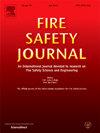风和坡度对移动火旋风行为的影响
IF 3.3
3区 工程技术
Q2 ENGINEERING, CIVIL
引用次数: 0
摘要
本文利用fire Dynamics Simulator(6.7.6)软件,数值研究了环境风和倾斜地形对移动火旋风行为的影响。设计了小型和大型l型火源、平坦地形线性火源、背风坡和峡谷地形线性火源等5种火源配置。分析了不同风速(U)和坡角(θ = 0°、10°、20°和30°)下火旋风的运动轨迹、编队的上、下临界风速(Uec)和平均运动速度(V)。除了平坦地形上的小尺度l型火涡表现出由顺风向逆风运动的过渡外,其他构型的火涡沿火线单向运动。通过切向速度场的同步演化揭示了火源与环境风的相互作用。本研究和文献的实验和数值结果证实了Uec的两个标度相关性,包括热释放率、风向和坡角。l型火源构型的无因次运动速度小于环境风速,而巴西型和背风坡构型的无因次运动速度大于环境风速。本文章由计算机程序翻译,如有差异,请以英文原文为准。
Effects of wind and slope on the behavior of moving fire whirls
This paper numerically investigates the effects of ambient wind and sloped terrains on the behavior of moving fire whirls using Fire Dynamics Simulator (6.7.6). Five configurations were designed, including small- and large-scale L-shaped fire sources and linear fire sources on flat terrain, as well as linear fire sources on leeward slope and canyon terrain. The movement trajectories, upper and lower critical wind speeds (Uec) for the formation, and average movement speed (V) of fire whirls were analyzed under varying wind speeds (U) and slope angles (θ = 0°, 10°, 20°, and 30°). Except for the fire whirls in the small-scale L-shaped case on flat terrain, which exhibit a transition from downwind to upwind movement, fire whirls move unidirectionally along the fire line in other configurations. The interaction between the fire source and ambient wind was revealed through the synchronized evolution of tangential velocity fields. Two scaling correlations for Uec, incorporating heat release rate, wind direction, and slope angle, were developed and confirmed by both experimental and numerical results from this study and the literature. The dimensionless movement speed was lower than the ambient wind speed in the L-shaped fire source configurations, but exceeded it in Brazil-type and leeward slope configurations.
求助全文
通过发布文献求助,成功后即可免费获取论文全文。
去求助
来源期刊

Fire Safety Journal
工程技术-材料科学:综合
CiteScore
5.70
自引率
9.70%
发文量
153
审稿时长
60 days
期刊介绍:
Fire Safety Journal is the leading publication dealing with all aspects of fire safety engineering. Its scope is purposefully wide, as it is deemed important to encourage papers from all sources within this multidisciplinary subject, thus providing a forum for its further development as a distinct engineering discipline. This is an essential step towards gaining a status equal to that enjoyed by the other engineering disciplines.
 求助内容:
求助内容: 应助结果提醒方式:
应助结果提醒方式:


